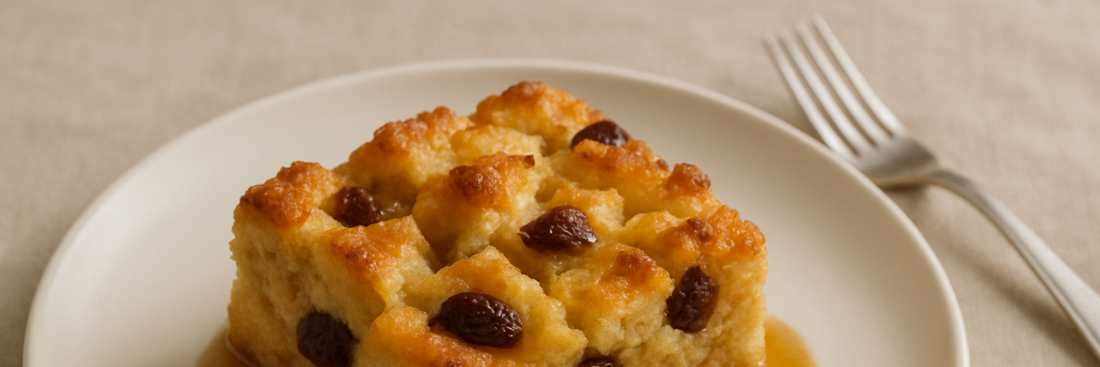How long does bread pudding last? If you’ve made a delicious batch of this classic custard dessert, you might be wondering how long you can safely enjoy the leftovers. Since bread pudding is made with milk, cream, and eggs, its shelf life is limited — and improper storage can lead to spoilage or even foodborne illness. In this guide, we’ll break down exactly how long bread pudding lasts in the fridge and freezer, how to store it correctly, and how to tell if it’s gone bad.
How Long Does Bread Pudding Last in the Refrigerator?
Bread pudding typically lasts 3 to 5 days in the refrigerator when stored properly. This shelf life depends on several important factors, including ingredients, storage method, and refrigeration conditions.
Ingredients: The Freshness of Dairy and Eggs Matters
Bread pudding is a custard-based dessert made with milk, cream, and eggs — all highly perishable ingredients. The freshness of the dairy and eggs used in your recipe directly affects how long the pudding will stay safe to eat. If made with close-to-expiry ingredients, the pudding may spoil sooner, even if refrigerated.
Storage Method: Use an Airtight Container
To maximize its shelf life, store the pudding in an airtight container. Exposure to air accelerates spoilage and can cause the pudding to dry out or absorb odors from other foods in the fridge. Covering the surface with plastic wrap or a tight-fitting lid helps maintain moisture and prevent contamination.
Refrigerator Temperature: Keep It at or Below 40 °F (4 °C)
Your refrigerator should be set to 40°F (4°C) or lower to keep perishable foods like bread pudding safe. Higher temperatures allow bacteria like Listeria and Salmonella to multiply more quickly, potentially leading to spoilage and foodborne illness.
Time Left at Room Temperature Before Refrigeration
One often-overlooked factor is how long the pudding sits at room temperature before refrigeration. The general food safety guideline is to refrigerate within 2 hours of baking or serving. Leaving bread pudding out longer than this increases the risk of bacterial growth, which can shorten its shelf life even if you later refrigerate it.

How Long Does Bread Pudding Last in the Freezer?
If you want to store bread pudding for longer than a few days, freezing is an excellent option. Bread pudding can last up to 2 to 3 months in the freezer when stored correctly.
Best Way to Wrap and Freeze Bread Pudding
To preserve both flavor and texture, it’s crucial to wrap the pudding properly before freezing. Follow these steps:
-
First, let the pudding cool completely to prevent condensation inside the packaging.
-
Wrap the entire dish or individual slices tightly in plastic wrap, ensuring no parts are exposed to air.
-
Then, add a second layer using aluminum foil or place the wrapped pudding in a freezer-safe airtight container or zip-top freezer bag.
Label the package with the date of freezing so you can track how long it's been stored.
Texture Changes After Freezing
While freezing helps extend the life of bread pudding, it may affect its texture upon thawing. Due to the custard base, some puddings can turn slightly grainy or dry once defrosted, especially if overbaked or left in the freezer for too long. To improve texture after thawing, consider adding a splash of cream or sauce before reheating.
Can Bread Pudding Sit Out at Room Temperature?
Bread pudding should not be left out at room temperature for more than 2 hours. This guideline is based on food safety recommendations from the USDA for perishable, dairy- and egg-based dishes.
Safe Time Limit: 2 Hours or Less
Because bread pudding contains milk, cream, and eggs, it is considered a high-risk food when not refrigerated. Harmful bacteria such as Salmonella, Listeria, and E. coli can begin multiplying rapidly when food is kept between 40 °F and 140 °F (4–60 °C) — also known as the "danger zone" — for more than two hours.
Why You Shouldn’t Leave Custard-Based Pudding Unrefrigerated
Custard-based desserts like bread pudding are especially vulnerable to bacterial growth because of their high moisture and protein content. Even if the pudding looks and smells fine after sitting out, it may be unsafe to eat. Reheating does not guarantee safety, as some bacteria produce heat-resistant toxins.
To stay safe, refrigerate bread pudding within 1–2 hours of cooking or serving.

Signs Bread Pudding Has Gone Bad
Spoiled bread pudding is not always obvious at first glance. Be sure to check for the following warning signs before consuming refrigerated or frozen leftovers.
Changes to Smell, Texture, or Color
If the pudding develops a sour or “off” smell, that’s a clear sign it has gone bad. Texture changes such as excessive wetness, sliminess, or a separation of custard can also indicate spoilage. Darkening or discoloration, especially if not related to the original recipe, is another red flag.
Visible Mold or Off-Odor
Any visible mold — whether white, green, or fuzzy — is a definitive sign the bread pudding is no longer safe to eat. Even if the mold appears on just one part, the spores may have spread throughout the dish. A strong ammonia-like or rotten odor also suggests bacterial or fungal growth and means the pudding should be discarded immediately.
How to Store Bread Pudding Properly
Storing bread pudding correctly helps extend its freshness, retain moisture, and prevent foodborne illness.
Use Cling Wrap or Wax Paper/Parchment Paper Between Slices
When storing in the refrigerator, cover the pudding with plastic wrap or transfer it to an airtight container. If you’re storing multiple slices, place wax paper or parchment paper between layers to prevent sticking and keep the texture intact.
Refrigeration Tips
-
Store in a shallow airtight container for even cooling.
-
Label with the date so you can track freshness.
-
Always let the pudding cool to room temperature before refrigerating to avoid condensation and sogginess.
Freezing Individual Slices vs. a Full Dish
For convenience, freeze individual slices rather than the entire tray. This allows for easier portioning and quicker thawing. Wrap each slice in plastic wrap, then in foil, and place in a freezer-safe bag or container. If freezing a whole dish, use a sturdy freezer-safe container, and allow space for expansion.
Individual portions are ideal if you want to reheat only what you need, while whole-dish freezing works best for family-style serving.
FAQS About How Long Does Bread Pudding Last?
How many days does bread pudding last in the fridge?
About 3–5 days
Can you freeze bread pudding and how long will it last?
Yes, up to 2–3 months
Can bread pudding sit out overnight?
No — keep out ≤ 2 hours
How do I know if my bread pudding is bad?
Watch for mold, sour smell, or slime
What’s the best way to reheat refrigerated bread pudding?
Oven/toaster at 350 °F or quick microwave
Does freezing ruin bread pudding?
Quality may decline; freeze properly
How should I store bread pudding to last longer?
Use an airtight container, wrap slices, and freeze portions
Conclusion
Bread pudding can last up to 3–5 days in the refrigerator and 2–3 months in the freezer if stored properly. To keep it fresh and safe to eat, always use airtight containers, refrigerate within two hours of cooking, and follow food safety best practices. Whether you're saving leftovers or planning to freeze a batch for later, proper storage will help maintain its flavor, texture, and quality.







